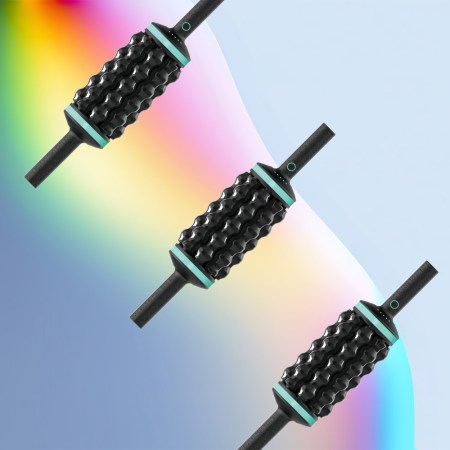As a health and fitness writer for a digital publication, I’d wager something like 80% of my Googles these days include keywords like “recovery,” “ergonomic,” or “good for you.”
As a result — by some shady, backchannel wizardry that I hope to never fully understand — my social media platforms have picked up on those searches and constantly pepper me with ads for wellness products. I can’t scroll through pictures of my friends’ dogs without some “disruptive” brand pledging to fix a part of my body.
One of the most frequent offenders these days is the so-called posture corrector, an apparatus intended to protect us from our natural-born preference for slouching. To be fair, the marketers are on point here; I’ve been intent on perfecting my workplace form ever since an exercise physiologist tore it to shreds a few years back. I’m an everyday runner, and he quickly traced the tightness I was experiencing in my lower half to my poor posture during work.
But something about the not-inexpensive correctors feels off…similar to other wellness inventions like “breathing trainers” or “jaw sculptors.” We dig into the details below.
This Chart Will Simplify Your “Recovery Fitness” Routine
Some strategies help heal the body. Others are a waste of time.An Refresher in Ergonomics
Ideally, while working on a computer, your eyes are level with the top third of your screen. Your back’s flat against a supportive chair, your feet are on the floor, and your elbows are tucked against your sides as you type. It might feel silly to sit like that. You’ll look like a studious T-Rex. But it’s so important. Having bad posture means messing with the main thoroughfare of your skeletal system: the spine. For those who exercise a lot, improper spinal alignment can increase your chances of overuse injuries. For those who don’t, it’ll eventually cause endless back pain.
Why We’ve All Started Paying Attention
Even back before the pandemic, ergonomics had emerged as a billion-dollar industry. That’s not necessarily because Americans are interested in sitting correctly: a survey conducted in late 2019 found that less than half of Americans actually care about maintaining proper posture. It was because the experts kept beating the drum regardless, in an effort to save us from ourselves. Towards the end of the decade, corporations spent a lot of money in support of that mission.
Meanwhile, it’s likely that the American sensibility has shifted a bit as of late. It’s hard to ignore the efficacy of your WFH setup after years of hybrid work schedules. Plus — there’s been a ton of literature on this sort of thing. We’ve all heard more than enough on the importance of putting some distance between your place of sleep and place of work, the difference Zooming near a natural light source can make, the fact that laptops belong on stands, not our laps.
How to Pepper Your Daily Routine With “Movement Snacks”
This wellness tip comes courtesy of the parkour communityAs for Posture Correctors
Where do posture correctors fit into all of this? For a suddenly posture-conscious populace, they seem to represent a quick fix. To be clear, they’ve been around for years now. Especially in the form of neoprene girdles, which pull the scapula back while encouraging the neck to stack vertically atop the spine. (Good luck hunching while wearing one.) They look a bit like sports bras or lifting vests. Recently, there are “electric” posture correctors, too. These are the ones I keep seeing in my feeds — tiny devices that affix to the back via magnet (through your shirt) or adhesive, and administer a zap whenever your posture gets too lazy.
I can understand the appeal. When it comes to wellness, it’s just easier to outsource. We just don’t trust ourselves. We want coaches, even if they’re sheets of fabric or small clips of plastic. But listen: there is no good reason for you to buy yourself a posture corrector. The vibrating iteration, for starters, is absolutely out of the question. (FYI: the two major brands selling it right now are called Strack and Upright.) These gizmos sync to apps that essentially gamify your posture. They offer an “upright versus slouch” score at the end of each day, and congratulate you for sneaks of good behavior.
Steer Clear of These Devices
If you’re going to get into health monitoring, this is not it. This is a service that tells you exactly one thing about your wellness. That’s a terribly outdated model. Yes, maintaining good posture can lead to all sorts of tangential benefits — increased flexibility, a reduced risk of arthritis, even a better mood — but sitting the right way all day is not the golden ticket to achieving those things. You’re still sitting. All. Day. As with most flawed fitness products, this is ultimately a false idol. It’s quackery shrouded in the trappings of a lifestyle brand, all for the low-low cost of $99.99. Posture correctors have the unique distinction of being way too expensive (don’t waste your money on them) and far too cheap (if you care about your posture, maybe buy a reliable office chair?) at the same time.
There are physiological shortcomings at play, too. When the body relies on a foreign piece of equipment to achieve a functional task — like: sit up, bring your shoulders back — the mind-muscle connection is disrupted. That’s what makes the digitized version so problematic. Those electric impulses should be firing from your cerebellum. You should be realizing you shouldn’t be slouching; a device shouldn’t do the work for you. The old-school correctors aren’t off the hook, either. A study published by Scandinavian researchers in 2019 found little credible evidence that “wearable” posture correctors worked.
Better Your Biomechanics on Your Own
Those elastic straps will put your back where it needs to be, but in the long run, you’re better served by earning those biomechanics on your own. As Dr. Robert Zembrowski told us in our guide to defeating low back pain, we need to be wary of “artificially” creating good posture. You want to get better at sitting? Firm up your core. An engaged midsection is the best way to keep everything where it needs to be.
Instead of suiting up every time you need to send an email, I recommend listening to your body a bit more and taking stock of your 9-5 proclivities. Can you spend an hour less of your workday on the couch? Is your primary workstation up to snuff? Have you tried the occasional desk exercise? We’ve got some golden options for you right here, from neck extensions, to shoulder blade stretches, to toe points. And when in doubt, add a couple days of yoga to your weekly routine.
It’s so tempting to think that our not-so-great habits can be solved with a product that literally has the word “corrector” in its name. But wellness is holistic. It’s a slow-burn — fine-tuned every day and impaced by thousands of tiny decisions. One of those decisions today? Don’t buy crap like this.
Whether you’re looking to get into shape, or just get out of a funk, The Charge has got you covered. Sign up for our new wellness newsletter today.


























